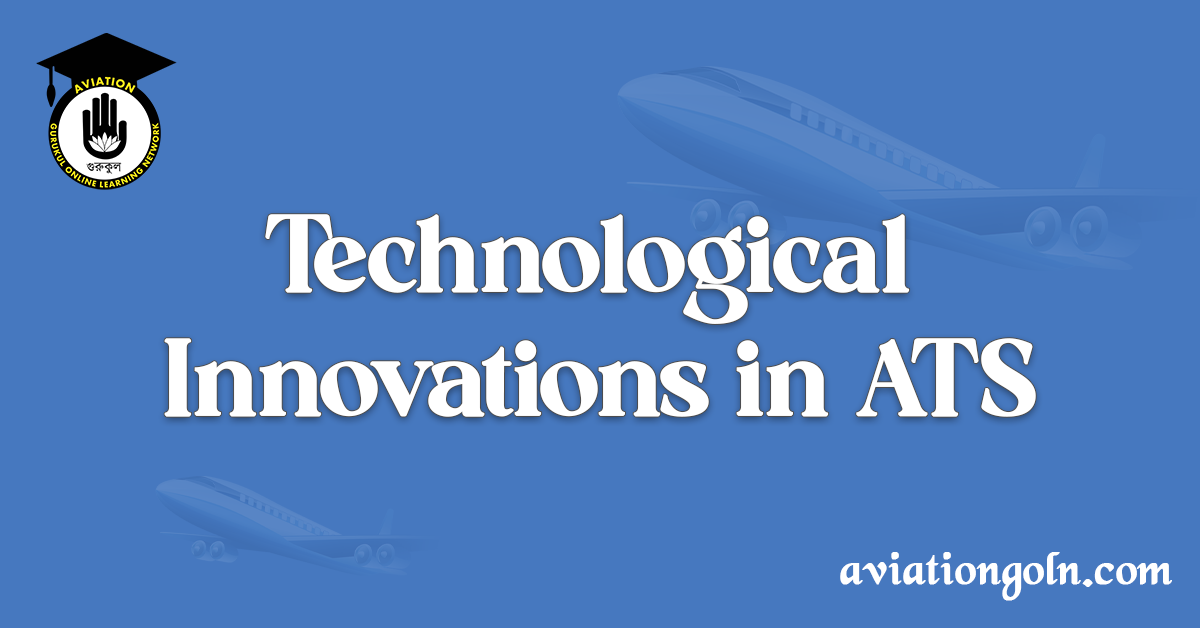Technological Innovations in ATS: Air Traffic Services (ATS) form the backbone of global aviation, ensuring safe and efficient air travel. ATS includes Air Traffic Control (ATC), Air Traffic Flow Management (ATFM), and Aeronautical Information Services, all working in unison to maintain a smooth and secure airspace. As technology continues to evolve at a rapid pace, the future of ATS is being reshaped. New systems, tools, and methodologies are being developed and deployed, contributing to increased efficiency, safety, and capacity within the sector.
Technological Innovations in ATS

Traditional ATS and Challenges
The traditional air traffic management system is predominantly human-centered, with air traffic controllers making critical decisions based on available data and rules. But with growing air traffic, the system has faced several challenges, such as airspace congestion, increased workload for air traffic controllers, and environmental concerns related to aircraft emissions. There is a pressing need to make air traffic services more efficient, reliable, and environmentally friendly. This is where technological innovations come into play.

Technological Innovations in ATS
Several technological innovations are poised to revolutionize the future of ATS, enabling automation, enhancing communication, improving accuracy, and increasing the overall capacity of the airspace. Here are some significant innovations:
1. Digital Remote Towers
Digital remote towers represent a significant shift in air traffic control. By using high-definition cameras and sensors placed around the airfield, data is transmitted to a remote location where air traffic controllers monitor and manage air traffic. This technology enables controllers to manage multiple airports from a single location, leading to improved efficiency and reduced costs.
2. Artificial Intelligence (AI) and Machine Learning (ML)
AI and ML are increasingly being used to predict and manage air traffic flows. These technologies can analyze large amounts of data to predict potential congestion, manage flight paths, and optimize airspace utilization. For instance, AI can be used to develop algorithms that predict flight delays, allowing ATC to manage schedules proactively and minimize disruptions.
3. Data Link Communication
Data link communication allows direct digital communication between controllers and pilots, reducing reliance on voice communication. This technology increases the speed and accuracy of communication, significantly reducing the chances of miscommunication or misunderstanding that can lead to safety incidents.

4. Automated Dependent Surveillance-Broadcast (ADS-B)
ADS-B is a surveillance technology that allows aircraft to determine their position via satellite navigation and periodically broadcast it, enabling them to be tracked. The information can be received by air traffic control ground stations and other aircraft, providing situational awareness and information-rich surveillance data.
5. Unmanned Aircraft System Traffic Management (UTM)
As the use of unmanned aircraft systems (UAS), including drones, increases, so does the need for a traffic management system. UTM is being developed to manage drone traffic, particularly in low-altitude airspace. This system will rely heavily on automation and real-time data sharing, potentially using technologies like blockchain for secure data transfer.
6. Blockchain Technology
Blockchain technology could offer significant advantages in securing data transfer in ATS. It can be used to create an immutable record of data exchanges, which can be crucial for tracking flights, recording instructions, and verifying information.
7. Quantum Computing
While still in its early stages, quantum computing holds immense potential for ATS. Quantum computers can solve complex problems far more quickly than classical computers. In ATS, they could help optimize flight paths in real-time, calculate the most efficient way to reroute flights around bad weather, or quickly resolve scheduling changes.

The Future of ATS
The above technological innovations are only the beginning. As we look towards the future, we can see an airspace that is safer, more efficient, and more environmentally friendly. Here are some ways in which the future of ATS might evolve.
1. Increased Automation
While humans will always play a crucial role in ATS, we can expect to see increased automation. Machine learning algorithms will handle routine tasks, reducing the workload for air traffic controllers and allowing them to focus on more complex situations.
2. Real-Time Decision-Making
With the advent of advanced data analysis and predictive modeling, real-time decision-making will become the norm. Controllers will have the tools to predict and manage traffic flow, leading to reduced delays and increased efficiency.
3. Greater Collaboration
Improved data sharing will enable greater collaboration between different stakeholders, including airlines, airports, air traffic controllers, and meteorological services. This collaboration will allow for better planning and coordination, ensuring smoother and more efficient operations.
4. Environmentally Friendly Operations
Technological advancements will enable more efficient flight paths and better traffic management, leading to reduced fuel consumption and lower emissions. We may also see the introduction of electric aircraft and other environmentally friendly technologies into the airspace.
5. Seamless Integration of Manned and Unmanned Aircraft
With the growing use of drones and the future introduction of air taxis, the airspace is set to become more crowded. Future ATS will need to seamlessly integrate these new types of aircraft into the existing airspace, ensuring safety and efficiency.

The world of aviation is on the brink of a technological revolution, and ATS is at the forefront of these changes. The integration of AI, machine learning, data link communication, blockchain, and other cutting-edge technologies will drastically transform the ATS landscape. These advancements will lead to enhanced efficiency, safety, capacity, and environmental sustainability, setting the stage for a future where the sky’s potential can be fully realized.
